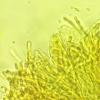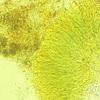
20-12-2025 23:08
Patrice TANCHAUDBonsoir, récolte sur sol sablonneux dans l'arri�

20-12-2025 15:47
Mirek GrycHi.These grew on pine wood that was heavily covere

18-12-2025 21:17
Pol DebaenstThe identification took me to Byssonectria deformi

15-12-2025 07:09
 Danny Newman
Danny Newman
indet. Rutstroemiaceae sp. on unk. fallen leavesMc

19-12-2025 10:10
Patrice TANCHAUDBonjour, récolte réalisée en milieu dunaire, a

18-12-2025 17:23
 Bruno Coué
Bruno Coué
Bonjour,je serais heureux d'avoir votre avis sur c

18-12-2025 18:07
Margot en Geert VullingsThese plumes were found on rotten wood.They strong

17-12-2025 18:35
 Michel Hairaud
Michel Hairaud
Bonjour à tous/Hi to everyone I am passing along
 Hi All,
Hi All,In April I found what I believe to be Trizodia acrobia in carr woodland in North Wales. This poorly known species would be a new genus to Britain. The only thing is that the ascomata were growing on a waterlogged stick rather than on Sphagnum as in Fungi of Temperate Europe so I was wondering if this is important or if there are other Trizodias out there. Also, I've been told that some lichenologists regard it as a lichen owing to its association with cyanobacteria. I was wondering what the latest state of play is on this.
Here is a description of the North Wales material:
Trizodia acrobia, Morfa Bychan, North Wales, (VC48, SH547369), 13/4/23.
Ascomata consisting of more or less globose, whitish, gelatinous pustules up to c.0.5mm, seated or even immersed in algal scum.
Asci: clavate, rather thick walled, 80-98x14-16µm.
Ascospores: 14-15x7.5-9 µm, pyriform.
Hyphae hyaline, thin to slightly thick-walled, 2-3 wide.
Paraphyses somewhat flexuose, slightly swollen to 3-4.5 at apex, sometimes branching, septate.
Best wishes,
Charles.


Many thanks for your response. Here are a couple of photos showing a very slight blueing of the asci en masse-perhaps my Melzer's needs replacing! Individual asci don't seem to show much reaction. Didn't realise that Mniaecia could be gelatinous like this.
Best wishes,
Charles.


Thanks for this. I don't think I pretreated the material with KOH. Could have a go with the dried material if I can find where the apos were!
Charles.


Yes, I did! I can see now, got the date wrong.
Charles.

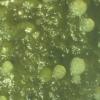
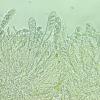
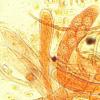
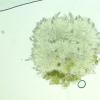
 rsz-trizodia-acrobia-paraphyses-morfa-bychan-13423-0001.jpg
rsz-trizodia-acrobia-paraphyses-morfa-bychan-13423-0001.jpg